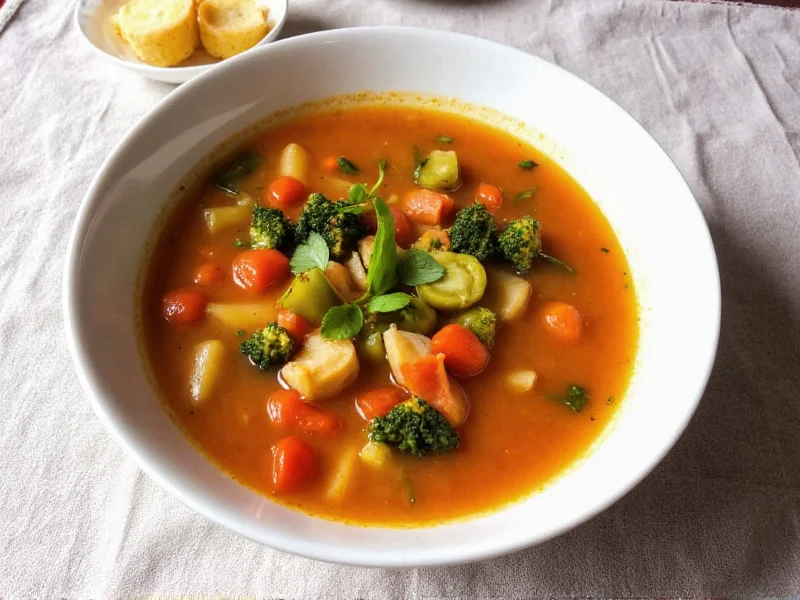Originating in ancient Rome as a practical way to use available ingredients, vegetarian minestrone has evolved into one of Italy's most beloved comfort foods. Unlike traditional versions that might include pancetta or chicken broth, the vegetarian adaptation relies on aromatic vegetables, quality olive oil, and umami-rich ingredients like tomatoes and Parmesan rind to create deep flavor without animal products.
The Cultural Significance of Minestrone
Minestrone's name comes from the Italian word "minestra," meaning "soup," with "-one" serving as a augmentative suffix. Historically, this soup represented cucina povera (poor kitchen) philosophy—transforming simple, affordable ingredients into nourishing meals. Each Italian region developed its own variation based on locally available produce, making minestrone a true reflection of seasonal eating long before it became a modern culinary trend.
Essential Ingredients for Authentic Flavor
The magic of vegetarian minestrone lies in its soffritto—the holy trinity of Italian cooking consisting of onions, carrots, and celery. This flavor base, slowly sautéed in olive oil, creates the soup's aromatic foundation. Additional key components include:
| Ingredient Category | Essential Components | Vegetarian Substitutes |
|---|---|---|
| Broth Base | Vegetable stock, tomato products | Homemade vegetable stock (avoid canned "vegetable broth" with artificial flavors) |
| Beans | Cannellini, borlotti, or chickpeas | Pre-soaked dried beans for superior texture and flavor |
| Pasta/Rice | Ditalini, small shells, or rice | Gluten-free pasta or extra beans for gluten-free version |
| Umami Boosters | Parmesan rind, sun-dried tomatoes | Miso paste (1 tsp) for vegan option |
Step-by-Step Preparation Guide
Creating exceptional vegetarian minestrone requires attention to technique rather than expensive ingredients. Begin by preparing your soffritto: finely dice equal parts onion, carrot, and celery (aim for 1:1:1 ratio by volume). Sauté these in high-quality olive oil over medium-low heat for 10-15 minutes until softened but not browned—this slow cooking develops natural sweetness without caramelization.
Next, add garlic and cook for 1 minute until fragrant. Stir in tomato paste and cook for 2-3 minutes to eliminate raw flavor and deepen the color. This step, called "blooming" the tomato paste, significantly enhances the soup's flavor profile. Add your beans (preferably pre-soaked dried beans that have been partially cooked), chopped tomatoes, and vegetable stock. Include a Parmesan rind if available—it adds remarkable depth without making the soup non-vegetarian (check cheese labels as some contain animal rennet).
Simmer the soup gently for 30-40 minutes to allow flavors to meld. Add delicate vegetables like zucchini and green beans during the last 15 minutes of cooking. Stir in pasta during the final 10 minutes, being careful not to overcook it. Finish with a generous drizzle of olive oil and fresh basil just before serving.
Nutritional Benefits Worth Noting
Vegetarian minestrone stands out as a nutritionally complete meal. A single serving typically contains 250-350 calories with balanced macronutrients: 12-15g protein from beans and pasta, 8-10g fiber from diverse vegetables, and healthy fats from olive oil. The soup delivers significant amounts of vitamins A, C, and K, plus minerals like potassium and magnesium. Unlike many commercial soups, homemade vegetarian minestrone contains no added sugars and minimal sodium when prepared with care.
Seasonal Variations for Year-Round Enjoyment
True to its Italian roots, the best vegetarian minestrone changes with the seasons. In spring, incorporate fresh peas, asparagus, and leafy greens. Summer versions shine with ripe tomatoes, zucchini, and fresh basil. Autumn brings squash, cabbage, and hearty greens like kale. Winter minestrone benefits from root vegetables, cabbage, and dried beans. This adaptability makes minestrone an ideal vehicle for seasonal eating and reducing food waste by using whatever produce needs using up.
Troubleshooting Common Issues
Many home cooks encounter challenges with minestrone. If your soup tastes flat, you likely need more acidity—add a splash of red wine vinegar or lemon juice. For overly thick soup, gradually add hot water or additional stock. If pasta becomes mushy, cook it separately and add to individual bowls. When reheating leftovers, remember that pasta continues absorbing liquid—have extra broth on hand to refresh the consistency. For enhanced flavor development, prepare minestrone a day ahead; the flavors deepen beautifully overnight.
Serving and Storage Recommendations
Serve vegetarian minestrone hot with a sprinkle of freshly grated Parmesan (or nutritional yeast for vegan version) and a drizzle of high-quality olive oil. Pair with crusty bread for dipping. Properly stored in airtight containers, minestrone maintains quality for 4-5 days in the refrigerator. For longer storage, freeze portions for up to 3 months—omit pasta if freezing, adding it fresh when reheating. The soup actually improves after freezing, making it ideal for meal prep.
Frequently Asked Questions
Can traditional minestrone soup be vegetarian?
Yes, authentic minestrone has vegetarian roots as a peasant dish using available vegetables. Traditional versions didn't originally contain meat, though some modern recipes add pancetta. True Italian minestrone focuses on vegetables, beans, and pasta in vegetable broth.
How do you thicken vegetarian minestrone soup naturally?
For natural thickening without flour, blend 1-2 cups of the finished soup and return it to the pot. Alternatively, mash some beans against the pot side during cooking. The starch from potatoes or pasta also thickens the broth as it simmers.
What's the difference between minestrone and vegetable soup?
Minestrone specifically includes pasta or rice, beans, and tomatoes as essential components, with a soffritto base. Vegetable soup lacks these defining elements and typically has a simpler broth with chopped vegetables only.
Can I make vegetarian minestrone soup gluten-free?
Absolutely. Substitute gluten-free pasta or increase the bean quantity. Many traditional Italian versions use rice instead of pasta, which is naturally gluten-free. Just ensure your vegetable broth is certified gluten-free if needed.
How long does homemade vegetarian minestrone last in the refrigerator?
Properly stored in airtight containers, vegetarian minestrone maintains freshness for 4-5 days in the refrigerator. The flavors often improve on day two as ingredients meld. For best results, store pasta separately if meal prepping for multiple days.











 浙公网安备
33010002000092号
浙公网安备
33010002000092号 浙B2-20120091-4
浙B2-20120091-4